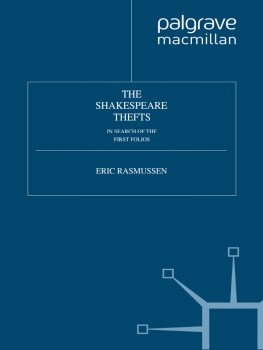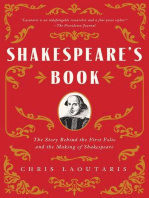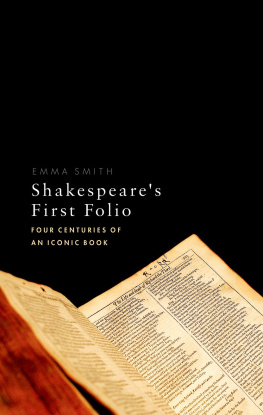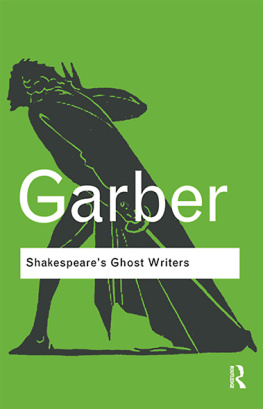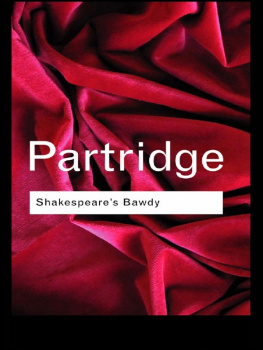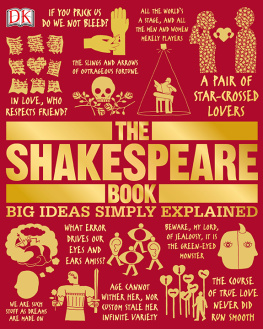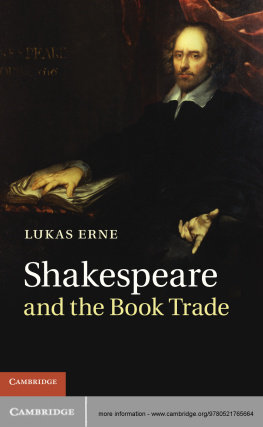ADDITIONAL PRAISE FOR
THE SHAKESPEARE THEFTS
Every book comes with a story, and great books, like comets, often carry in their wake a tail of great stories. Eric Rasmussen, who with a team of fellow scholars is engaged in tracking and examining every known copy of Shakespeares First Folio, has unearthed wonderful anecdotes of theft, fraud, and the peculiar mania of passionate bibliophiles.
Stephen Greenblatt, author of Will in the World: How Shakespeare Became Shakespeare
A page-turner, a series of detective stories and a work of scholarship all at onceEric Rasmussen brings to life a truly Shakespearean cast of characters as he tracks the First Folio down the centuries and around the world.
Jonathan Bate, author of Soul of the Age: A Biography of the Mind of William Shakespeare
Shakespeares First Folio contains thirty-six plays of wit, passion, crime, and folly. In this brisk and amusing account, Eric Rasmussen tells us how the book itself has been the cause of wit, passion, crime, and folly in those who seek to own one of the surviving copies.
Peter Saccio, author of Shakespeares English Kings: History, Chronicle, and Drama
Eric Rasmussens fascinating and hugely enjoyable collection of tales about the fate of individual copies and of his own experiences accumulating the data for a census of the surviving copies is a joy from first to last. Stories of thefts old and new, of copies mutilated or destroyed, and of the mania of book-collecting cover the centuries from its first purchasers to its most recent thieves. For anyone who thinks the work of scholarship is as dry as libraries, The Shakespeare Thefts will quickly convince them that it is actually a cross between CSI and big-game hunting.
Peter Holland, author of William Shakespeare
The Shakespeare Thefts is an irresistible true-crime story revealing the long history of the desire to own one of the worlds most valuable books. Amidst his captivating tales of unscrupulous scholars, wealthy industrialists, avaricious con men, and even a Pope who wanted to own the First Folio, Rasmussen makes clear his own love for and deep knowledge about the first collected edition of Shakespeares plays, gently sneaking in a rich bibliographic history of the book itself as he unfolds his engaging accounts of those who were willing to steal to own it.
David Scott Kastan, author of Shakespeare and the Book and General Editor of the Arden Shakespeare
With irresistible intrigue like that of fine mystery novels, erudition and rigor characteristic of the most esteemed scholarship, and a delightful readability that only the best popular fiction boasts, this book will bring great joy to a remarkable range of people, from anyone who gives a hoot about Shakespeare to aficionados of literary history to simply lovers of good stories. It is no surprise that a team of researchers assisted Rasmussen, for it more often than otherwise takes a collaboration of brilliant minds to produce extraordinary work. And extraordinary this book is.
Bryan Reynolds, author of Performing Transversally
Book-trade Rosencrantzes and Guildensterns are very much alive in this entertaining collection of interlocked tales. Purposes mistook fallen on their inventors heads, accidental judgments, casual pilferings, and acts which, if not carnal and bloody, are certainly intriguingall this Rasmussen delivers in recounting his teams pursuit of the missing First Folios.
John Michael Archer, author of Citizen Shakespeare
THE
SHAKESPEARE
THEFTS
THE
SHAKESPEARE
THEFTS
IN SEARCH OF THE FIRST FOLIOS
ERIC RASMUSSEN


THE SHAKESPEARE THEFTS
Copyright Eric Rasmussen, 2011.
All rights reserved.
First published in 2011 by PALGRAVE MACMILLAN in the United Statesa division of St. Martins Press LLC, 175 Fifth Avenue, New York, NY 10010.
Where this book is distributed in the UK, Europe and the rest of the world, this is by Palgrave Macmillan, a division of Macmillan Publishers Limited, registered in England, company number 785998, of Houndmills, Basingstoke, Hampshire RG21 6XS.
Palgrave Macmillan is the global academic imprint of the above companies and has companies and representatives throughout the world.
Palgrave and Macmillan are registered trademarks in the United States, the United Kingdom, Europe and other countries.
ISBN 978-0-230-10941-4
Library of Congress Cataloging-in-Publication Data is available from the Library of Congress.
A catalogue record of the book is available from the British Library.
Design by Letra Libre, Inc.
First edition: October 2011
10 9 8 7 6 5 4 3 2 1
Printed in the United States of America.
For Vicky, Tristan, and Arden
To the great Variety of Readers,
It had been a thing, we confess, worthy to have been wished, that the author himself had lived to have set forth and overseen his own writings. But since it hath been ordained otherwise, and he by death departed from that right, we pray you do not envy his friends, the office of their care, and pain, to have collected and published them.
John Heminges and Henry Condell, Epistle to the Shakespeare First Folio
PREFACE
A LITERARY DETECTIVE STORY
There are 232 known copies of the Shakespeare First Folio in the world. A team of First Folio hunters and I have spent over a decade locating and examining surviving copies. These investigations have taken us on a journey around the globe. Along the way, we have uncovered a wealth of fascinating information about folios that have been stolenor vanishedover the past four hundred years.
To appreciate the importance of the First Folio, bear this in mind: Only half of Shakespeares plays were printed during his lifetime. Those that made it into print were produced in cheap paperback form, about the size and shape of comic books, and they were called quartos.
So, after Shakespeare died, Heminges and Condell took matters into their own hands and began work on an authorized, prestigious hardcover folio containing all of the playwrights dramatic works: thirty-six plays, eighteen of which had never been published before. They envisioned an impressive folio, the prestigious format that was used for works by the leading theologians, philosophers, and historians of the age, such as Holinsheds Chronicles (1587), Richard Hookers Laws (1611), Sir Walter Raleighs History of the World (1614), and William Camdens Annals (1615). The groundbreaking edition of Ben Jonsons Workes (1616) marked the first time that the work of a playwright had ever been published in folio. However, Jonson was mocked by contemporaries, who wryly observed that he seemed not to understand the distinction between work and play. But the Jonson folio included prose and poetry as well as dramatic texts. A folio devoted entirely to plays was unprecedented and represented a considerable financial risk, but Shakespeares fellow actors accomplished the task. A magisterial 908-page book resulted, measuring an impressive fourteen inches tall by nine inches wide and three inches thick, arranged into three genres, Mr. William Shakespeares Comedies, Histories, & Tragedies, the First Folio.
Expected on the market by mid-1622, it was included in that years Frankfurt Book Fairs catalog as one of the books printed between April 1622 and October 1622. However, the project was a monstrous undertaking, and the book did not actually appear until very late in 1623. It was elegantan indignant contemporary complained that Shakespeares plays are printed on the best crown paper, far better than most Bibles. Some scholars argue that it was a runaway success, with demand being so great that a second editionthe Second Foliowas required within less than a decade. Others maintain that the First Folio was a financial disaster that bankrupted one of its publishers, Edward Blount.
Next page
